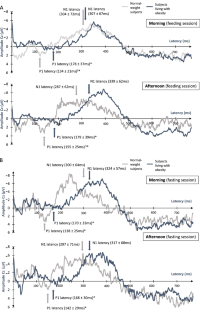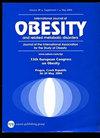与体重正常者相比,肥胖症患者对蔗糖溶液的味觉诱发电位潜伏期延长。
IF 4.2
2区 医学
Q1 ENDOCRINOLOGY & METABOLISM
引用次数: 0
摘要
目的:大脑皮层对味觉信息处理的不同可能会改变食物摄入量,从而导致肥胖症的发生。研究的主要目的是比较肥胖症患者(OB)和正常体重者(NW)在标准午餐前后对蔗糖溶液(10 g.100 mL-1)的味觉诱发电位(GEP)特征。次要目的是评估 GEP 与血浆中酰化胃泌素、瘦素、胰岛素和血清素水平之间的相关性:每名受试者随机接受 2 次训练,每次训练间隔 2 天。在一个疗程中,受试者禁食;在另一个疗程中,受试者进食低糖午餐。在每个疗程中,受试者在第一次记录 GEP 之前进行血液测试,然后在午餐后(进食疗程)或无午餐后(禁食疗程)进行第二次 GEP 记录:28 名 OB(体重指数:38.6 ± 9.0 kg.m-2)与 22 名 NW(体重指数:22.3 ± 2.2 kg.m-2)配对。与白种人相比,OB 的 GEP 潜伏期在午餐前后的任何时段和时间都有所延长(早上的 Cz:分别为 170 ± 33 ms vs 138 ± 25 ms;p 结论:该研究突出表明,OB 的激活速度较慢:本研究表明,与西北地区相比,OB 的味觉皮层激活速度较慢。本文章由计算机程序翻译,如有差异,请以英文原文为准。


Prolonged latency of the gustatory evoked potentials for sucrose solution in subjects living with obesity compared with normal-weight subjects
A difference in cortical treatment of taste information could alter food intake promoting the development of obesity. The main purpose was to compare, in subjects living with obesity (OB) and normal-weight subjects (NW), the characteristics of gustatory evoked potentials (GEP) for sucrose solution (10 g.100 mL−1) before and after a standard lunch. The secondary objective was to evaluate the correlations between GEP and the plasmatic levels of acylated ghrelin, leptin, insulin and serotonin. Each subject had 2 randomized sessions spaced by an interval of 2 days. During one session, subjects were fasting and during the other, subjects took a lunch low in sugar. In each session, subjects had a blood test before a first GEP recording followed by a second GEP recording either after a lunch (feeding session) or no lunch (fasting session). Twenty-eight OB (BMI: 38.6 ± 9.0 kg.m−2) were matched to 22 NW (BMI: 22.3 ± 2.2 kg.m−2). GEP latencies were prolonged in OB regardless the sessions and the time before and after lunch, compared with NW (in Cz at the morning: 170 ± 33 ms vs 138 ± 25 ms respectively; p < 0.001). The increase in latency observed in NW after lunch was not observed in OB. Negative or positive correlations were noted in all participants between GEP latencies and ghrelin, leptin, insulin plasmatic levels (P1Cz, r = −0.38, r = 0.33, r = 0.37 respectively, p < 0.0001). This study highlights a slower activation in the taste cortex in OB compared with NW.
求助全文
通过发布文献求助,成功后即可免费获取论文全文。
去求助
来源期刊

International Journal of Obesity
医学-内分泌学与代谢
CiteScore
10.00
自引率
2.00%
发文量
221
审稿时长
3 months
期刊介绍:
The International Journal of Obesity is a multi-disciplinary forum for research describing basic, clinical and applied studies in biochemistry, physiology, genetics and nutrition, molecular, metabolic, psychological and epidemiological aspects of obesity and related disorders.
We publish a range of content types including original research articles, technical reports, reviews, correspondence and brief communications that elaborate on significant advances in the field and cover topical issues.
 求助内容:
求助内容: 应助结果提醒方式:
应助结果提醒方式:


